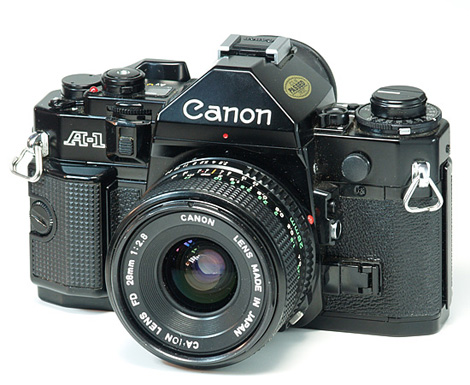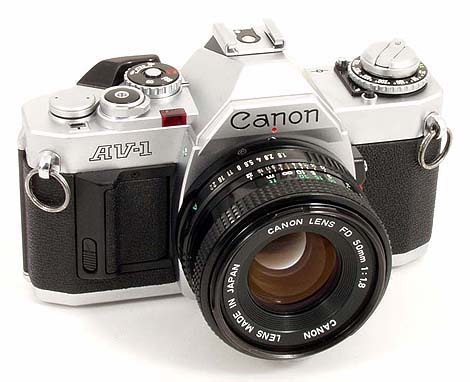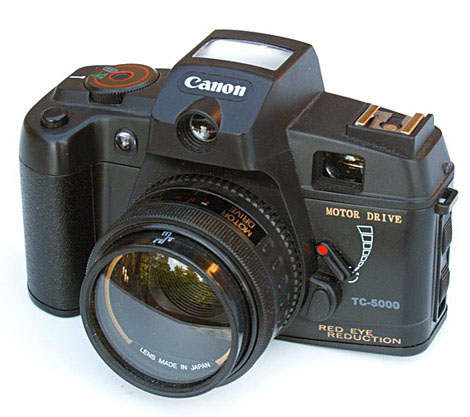
Canon A-1
In 1977 the Canon AE-1 marked the shift of cameras from manual models to electronic ones. It was an electronic SLR camera with a CPU which linked the electromagnetic release, self-timer, and electronic flash electronically. A year later in 1978, the Canon A-1 was introduced, the first camera in the world to have all exposure functions controlled by a microcomputer. It enabled aperture-prority and shutter-priority autoexposure.
"The A-1 has a cloth shutter, and it tends to stick at times or emit the dreaded Canon 'squeal'. Many used examples have broken or taped battery doors. These are the complaints often directed to this progressive masterpeace in camera manufacturing. Unlike the hardest competitor Nikon, Canon has changed the lens mounting and the current Canon EOS autofocus EF mount is not compatible with the FD-mount. Still it was definitely one of the most advanced contemporary cameras. Canon A-1 is the camera which the popularity of IC circuits for automations in camera design have very much to thank for. The camera is totally dependent on batteries. A feature which is more than a contingency today even on a toothbrush. In many aspects you get much more than you lose. The diversity and easiness of usage and the accuracy of functions got a new level with this beauty."
Canon A-1 was introduced in 1978 and despite of a quarter of a century this vintage camera still remains as the ultimate reference camera for many. Its styling, durability and reliability have been proven over these years and passed the enduring time test and emerged as a true classic. |
Specifications
Type: 35mm SLR camera with electronically controlled, multiple-mode AE (automatic exposure) and focal plane shutter.
Film format: 24 x 36mm.
Photographic Modes : Six modes, including 5 AE modes: Shutter-speed priority AE, Aperture priority AE, Programmed AE, full AE flash photography with specified Canon electronic flashes, and stopped-down AE and manual override.
Magnification: 0.83X at infinity with a standard 50mm lens.
Focusing Screen: Standard split-image microprism rangefinder
Viewfinder Information : Displayed in the form of LED digital readout below the visual field. Includes shutter speed, aperture, flashing warning of incorrect exposures and settings bulb indication, charge completion indicator with specified Canon flash units, manual aperture control signal, error indication for incorrect stopping-down operation.
Interchangeable Lenses: Canon FD lenses and most FL (for stopped-down AE) series lenses.
Standard Lenses: Canon FD 55mm and 50mm lenses.
Viewfinder: Fixed eye-level pentaprism.
Field of View: 93.5% vertical and 95.3% horizontal coverage of the actual picture area.
Mirror: Instant-return type with shock-absorbing mechanism.
Light Metering System: Through-the-lens (TTL) Central Emphasis metering by silicon photocell located just above eyepiece lens. Light reaches the silicon photocell after passing through a Fresnel lens condenser.
Film Speed Setting: ISO 6 to ISO 12800 in 1/3 step increments.
Meter Coupling Range: EVó2 to EV 18 at ISO 100 with FD 50mm f/1.4 lens. In the programmed AE mode, meter coupling range depends on the programmed shutter speed and aperture combinations.
Exposure Compensation: +2 f/stop scale gradations in increments of 1/3 of a gradation, with 1/4, 1/2, 1, 2, and 4 markings.
Exposure Preview: Viewfinder digital readout activated by pressing the shutter button halfway, or by pressing the exposure preview switch or the exposure memory switch.
Manual Override: Possible by disengaging the FD lens from the "A" mark and setting the AE mode selector to Tv. Aperture manually controlled with aperture ring, shutter speed with AT dial.
Shutter: Cloth focal plane shutter. Electronically controlled, stepless, from 30 sec. to 1/1000 sec.
Shutter Speeds: B, 30, 15, 8, 4, 2, 1, 2, 4, 8,15 30, 60, 125, 250, 500, 1000 plus P .
Shutter Release Button: Oversized, 2-step button with electromagnetic shutter release. Pressing it halfway activates meter circuit; pressing it all the way sets shutter in operation. Can be locked by setting the main switch to "L" to prevent accidental shutter release.
Power Source : One 6V silver oxide battery (Eveready No. 544, UCAR No. 544, JIS 4G13, Mallory PX28) or alkaline manganese battery (Eveready No. 537, UCAR No. 537, Mallory 7K34).
Battery Check : A red LED on top of the camera flashes on and off to indicate power level when the battery check button is pressed.
Multiple Exposure: Possible by setting multiple exposure lever before winding film advance lever to recock shutter.
Self timer: Electronically controlled, 2 or 10 seconds time lag. Activated by pressing shutter button. Red LED flashes to indicate its operation. Flashing frequency increases 2 sec. before shutter release.
Flash Synchronization : X-synch at 1/60 sec., FP- and M-sync at 1/30 sec.
Automatic Flash: Full AE flash photography with Canon Speedlites 199A, 177A, 155A and 133A.
Back Cover: Opened by pulling up rewind knob. Removable for attaching Data Back A.
Film Loading: Easy film loading with multi-slot take-up spool.
Film Advance Lever: Single-stroke 120° throw with 30° stand-off. Winding with several short strokes is possible. Automatic winding possible by mounting Canon Motor Drive MA or Power Winder A
Frame Counter: Additive type.
Size: (W x H x D) 141 x 91.5 x 47.5mm
Weight: 620 g (body only, including battery ) |

Canon AV-1
is a focal plane shutter SLR camera with a TTL light metering. Production begun in the first half of 1979. I bought this Canon because I just wanted to have another item of Canon SLR brand. Why then AV-1 ? Because it was relatively cheap and had a good reputation within the cameras of it´s class. It proved very handy and easy to use. It also takes technically excellent pictures.All you need to do is turn the aperture ring on the lens to set an aperture, focus and press the shutter button. Focusing is manual. The camera does all the rest - provided the main control dial has been set to the "A" mark..It has center weighted average light metering with a back light compensation possibility. When shooting your subject under backlighting condition, you just push an extra switch to compensate the exposure. At least in Finland it was commonly bundled with Canon FD 35-70 F 1:4 zoom lens |
Specifications
Type : 35mm SLR (Single-lens Reflex) camera with electronically controlled AE (Automatic Exposure).
Format : 24 x 36mm.
Usable Lenses : Canon FD (for full aperture AE) and most FL (for stopped-down AE) series lenses.
Lens Mount : Canon Breech-lock mount.
Viewfinder : Fixed, eye-level pentaprism.
Viewfinder Information : Split-image/micro prism rangefinder, shutter speed scale and meter needle, red over and underexposure warning indices, battery check/ camera shake warning index.
Shutter : Cloth, focal plane shutter with four spindles. Electronically controlled.
Shutter Release Button : Electromagnetic, two-step button. Pressing it halfway activates the meter; pressing it all the way sets shutter in operation. With lock and cable release socket.
strong>Shutter Speed : Step less automatically controlled, from 2 sec. to 1/1000 sec. Manual settings for B (Bulb) and X-synchronization speed of 1/60 sec. with flashes other than Canon Speedlite 133A, 155A, 177A or 199A.
ASA Film Speed Dial : ASA 25 to ASA 1600. With lock.
Light Metering System : Through-the-lens, Central Emphasis metering by SPC (Silicon Photocell).
Exposure Correction : Shutter speed is automatically reduced 1-1/2 steps to increase exposure by pressing back light control switch.
Reflex Mirror : Large instant-return type with shock absorbing mechanism.
Self-timer : Electronically controlled. Ten second time lag activated by pressing shutter button. Red LED blinks to indicate operation; flashing frequency increases two sec. before shutter release. Cancellation possible by pressing battery check button.
Flash Synchronization : At 1/60 sec. Set by switching selector dial to 60 for flashes other than the Canon Speedlite 133A 155A, 177A or 199A. Direct contact at accessory shoe.
Automatic Flash Control : With Canon Speedlite 133A, 155A, 177A or 199A. With selector dial at , shutter speed set to 1/60 sec. automatically. Aperture set manually on aperture ring to same aperture set on flash.
Back Cover : Fixed. Opened by pulling up rewind knob.
Film Loading : Via multi-slot take-up spool.
Film Advance Lever : Single-stroke 120 degree throw with 30 degree stand-off. Winding with several short strokes possible.
Battery: 6V, Mallory PX 28 or comparable.
Dimensions: (W x H x D) 139 x 85 x 48mm
Weight: 512g (body only, without battery)

Canon TC-5000
I hereby proclaim a competition to conceive of a new name to this exceedingly innovative high tech gadget. TC-50000 is absolutely too modest.
Something like,
Galactic XMTR Nano Supercharger Mark II
would be better.
(Edit: Aug 8, 2007) According to specialists the model name of this rare Canon camera could be Plasticam Sinonippon Bogusfocus PDQ or the more common WhatCopyright?100.
One thing is bothering me... Is the lens made of glass, because it is not mentioned anywhere?? |
|
|